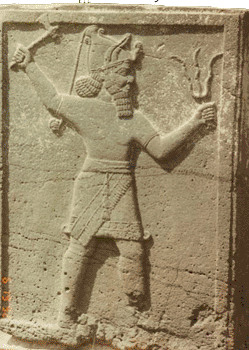
"Sometimes known as Aslantaş, the Lion Stone, Karatepe has an advantage for the visitor over many of the larger, more frequented sites. Troy, for example, is famously complex. The earliest remains date back to 3600 B.C., but it was a thriving city and part of the Roman Empire as late as A.D. 300. This breadth of history is fascinating but bewildering -- is this section of city wall I'm looking at Bronze Age, Hellenistic, Classical Greek -- or Roman? Karatepe's delight is that its history is so succinct. Confined to the ninth and eighth centuries B.C., archaeologists have found nothing either pre or post dating this brief period. Before you visit Karatepe, you may well know next to nothing about the so-called Neo-Hittite people who built and occupied this beautiful, wooded hilltop 1,800 years ago. But the site's very simplicity gently draws you and insistently tugs you to find out more.
So, who were the Neo-Hittites? The "golden age" of the Hittite Empire, centered around the imperial "capital" at Hattuşa, on the Anatolian plateau east of Ankara, lasted from around 1800 to 1200 B.C. On its collapse, the lands of the former empire dissolved into a number of independent city-states. These smaller entities are now termed Neo-Hittite. One of these was centered on the fertile Çukurova Plain around Adana. In the eighth century, its ruler was a king called Azatiwatas. He clearly thought he was special, as an inscription carved into the back of a statue found on the site reveals:
I am indeed Azitawatas,
The blessed of the sun, the servant of the Storm-God….
The Storm-God made me father and mother to the city of Adanawa,
And I developed the city of Adanawa,
And I enlarged the land of Adanawa, both to the west and to the east,
And in my days the city of Adanawa had prosperity,
Satiety and comfort, and I filled the arsenals of Pahara,
I added horse upon horse, shield upon shield,
Army upon army, all for the Storm-God and the Gods….
I brought prosperity to my race….
I built mighty fortresses on all my borders…
The last line quoted above is pertinent to the site. It seems Karatepe was one of the outlying fortresses built by the rulers of Adanawa (Adana) to protect their borders. Although formidable, the wall of the Toros Mountains to the north was not impregnable. From that direction wild people, such as the Scythians, posed a threat. Ironically, though, it was the Assyrians from the southeast who brought about the end the Neo-Hittite kingdoms around 700 B.C.
Karatepe then, was a citadel. Around a kilometer in circumference, its walls ran in an irregular oval around the top of a hill, which dominated the valley of the Ceyhan River. The lower courses of wall were stone, the upper mud brick. The citadel was entered by one of two T-shaped gates piercing, respectively, the southwestern and northeastern walls. Both were reached by sloping ramps and protected by flanking towers. The walk up to the southwest gate from the parking lot half a kilometer below is delightful, with the rough track dappled by sunlight, birds chattering away in the mixed woodland and the fierce heat of this part of Turkey tempered by altitude, shade and breeze. Occasional views across the soft, undulating foothills and the blue waters of the Aslantaş reservoir are beautiful..."
"...in 1947 excavations commenced. Over the next few years the wonders of Karatepe were slowly revealed -- the walls, the gateways, statues of a sphinx, lions and the magnificent statue of the Hittite storm-god Tarhunzas, astride a pair of bulls. Perhaps most evocative are the relief carvings which show scenes from mythology, war and everyday life. Thanks to the dedication of [archaeologist Halet] Çambel, all these statues and carvings have remained in situ, as they were in the days of Azatiwatas, and not carted off to the museum in Ankara..."
"...Derided by some as crude and primitive, the relief carvings have a charm and vibrancy, which helps us to imagine the people who lived here as ordinary human beings. The relief of a man on a chair is the king, but he is touchingly ordinary, sitting there with a meat patty in one hand, reaching out greedily for more. One relief shows a woman suckling a child beneath a date palm, others show musicians, sailors and warriors, hunters and servants.
It will probably only take you a couple of hours to wander around Karatepe, but everything you see is remarkable. The Semitic and hieroglyphic "writing," liberally scrawled over the carvings, enabled linguists to crack the Hittite code -- making them Turkey's own Rosetta Stone."
No comments:
Post a Comment